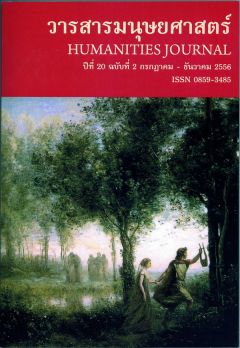โนรา: นาฏยศิลปะในฐานะเป็นพันธกิจอันศักดิ์สิทธิ์
Main Article Content
Abstract
บทความนี้เป็นการศึกษาการแสดงโนราในมุมมองแห่งเทพปกรณัม โดยศึกษาจากตัวบท คัมภีร์ หนังสือ เอกสารและการบันทึกเกี่ยวกับกำเนิด ที่มาขอนาฏยศิลป์และการแสดงโนรา รวมถึงการฝึกปฏิบัติโนรา เพื่อเชื่อมโยงระหว่างโนราและคัมภีร์นาฏยศาสตร์ อันแสดงให้เห็นว่าโนราเป็นนาฏยศิลป์ไทยที่ได้รับการถ่ายทอดมาจากอินเดีย มิใช่เพียงท่ารำเท่านั้น แต่รวมถึงองค์ประกอบต่างๆ และเป้าหมายของการแสดงด้วย
เป้าหมายของคัมภีร์นาฏยศาสตร์และโนรา คือ ช่วยนำพามนุษย์แทงทะลุโลกียะภาวะไปสู่มิติแห่งเทพปกรณัม อันจะนำไปสุ่ความเป็นหนึ่งเดียวกับพระผู้เป็นทิพย์ ในฐานะที่นาฏยศิลป์เป็นพระประทานจากเบื้องบน จึงได้มีเทวบัญญัติให้ประกอบพิธีกรรมต่างๆ ถวายแด่เทพเจ้า และการร่ายรำถือเป็นพันธกิจอันศักดิ์สิทธิ์ที่ต้องกระทำ หาไม่แล้วจะถูกตัดขาดจากเบื้องบน ทั้งยังไม่สามารถเข้าถึงความลึกลับหรือเชื่อมโยงกับสิ่งอื่นใดได้อีก
Nora: Dramatic Art as Sacrament
Jittima Nakeephet
This research is conducted to study Nora in view of Mythology by looking at relating texts, books, written documents and records about the origin of dramatic art and Nora dance. It also looks at Nora dance practice to find relationship between Nora and the Natya Sastra. This relationship shows that Nora dance, which is a Thai dramatic art, is not only a dance pattern influenced by Indian art but also includes other components and aims of the performance.
The aim of the Natya Sastra and Nora dance is to help humans go beyond worldly concern and reach the mythological dimension. In this way, humans could become a part of divinity. Dramatic Art, as the gift from the powerful gods above, is seen as a commandment which humans must perform as rituals for gods. By ignoring these rituals, human will not be able to connect with gods above as well as the mystery and other things.


